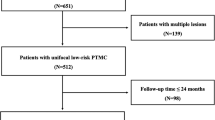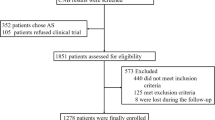Abstract
Objective
Minimally invasive therapies are gaining interest because of the indolence and excellent prognosis of low-risk papillary thyroid carcinoma (PTC). This study aimed to evaluate the outcomes of radiofrequency ablation (RFA) for low-risk PTC and to determine the effects of ablation on subsequent surgical management.
Methods
A medical record review was conducted including patients with low-risk PTC who underwent surgery after RFA from July 2015 to July 2021. Demographic characteristics, tumor characteristics, ablation procedures, surgical findings, and pathological changes were reviewed for all patients. The primary outcomes were surgical and pathological changes in post-ablation patients.
Results
Of the 10 patients with 11 PTCs, 9 (90%) were women; the median (SD) patient age was 41.5 (8.2) years. The maximum diameter range of PTCs was 3.0−12.0 mm. All 10 patients underwent rigorous RFA procedure involving a four-step approach, and had received surgical management. Intraoperatively, no patients had muscle and nerve injuries, and mild adhesion of the post-ablation lesions with the anterior cervical muscle was observed in two cases. Histopathologically, no residual PTCs were observed in the ablated areas in all patients. Central lymph node metastasis (LNM) was found in three (30.0%, pN1a). Occult PTCs were observed in three cases (30.0%).
Conclusions
Our findings suggest that low-risk small PTCs can be completely treated with rigorous RFA, which does not affect subsequent surgical management, if necessary. RFA may be a treatment option, but occult PTCs and clinically negative LNMs may be overlooked. Long-term follow-up data are necessary to further identify its efficacy.
Key points
• RFA can completely treat low-risk small PTC.
• RFA does not affect the subsequent surgical management if necessary.
• Because occult PTCs and clinically negative LNMs may be overlooked by RFA, long-term follow-up data are necessary to further identify its efficacy.



Similar content being viewed by others
Abbreviations
- CEUS:
-
Contrast-enhanced ultrasonography
- CNB:
-
Core needle biopsy
- FNA:
-
Fine-needle aspiration
- PTC:
-
Papillary thyroid carcinoma
- RFA:
-
Radiofrequency ablation
- US:
-
Ultrasound
References
Vaccarella S, Lortet-Tieulent J, Colombet M et al (2021) Global patterns and trends in incidence and mortality of thyroid cancer in children and adolescents: a population-based study. Lancet Diabetes Endocrinol 9:144–152
Sung H, Ferlay J, Siegel RL et al (2021) Global cancer statistics 2020: GLOBOCAN estimates of incidence and mortality worldwide for 36 cancers in 185 countries. CA Cancer J Clin 71:209–249
Leboulleux S, Tuttle RM, Pacini F, Schlumberger M (2016) Papillary thyroid microcarcinoma: time to shift from surgery to active surveillance? Lancet Diabetes Endocrinol 4:933–942
Miranda-Filho A, Lortet-Tieulent J, Bray F et al (2021) Thyroid cancer incidence trends by histology in 25 countries: a population-based study. Lancet Diabetes Endocrinol 9:225–234
Haugen BR, Alexander EK, Bible KC et al (2016) 2015 American Thyroid Association management guidelines for adult patients with thyroid nodules and differentiated thyroid cancer: the American Thyroid Association guidelines task force on thyroid nodules and differentiated thyroid cancer. Thyroid 26:1–133
Mauri G, Hegedus L, Bandula S et al (2021) European thyroid association and cardiovascular and interventional radiological Society of Europe 2021 clinical practice guideline for the use of minimally invasive treatments in malignant thyroid lesions. Eur Thyroid J 10:185–197
Orloff LA, Noel JE, Stack BC Jr et al (2022) Radiofrequency ablation and related ultrasound-guided ablation technologies for treatment of benign and malignant thyroid disease: an international multidisciplinary consensus statement of the American Head and Neck Society Endocrine Surgery Section with the Asia Pacific Society of Thyroid Surgery, Associazione Medici Endocrinologi, British Association of Endocrine and Thyroid Surgeons, European Thyroid Association, Italian Society of Endocrine Surgery Units, Korean Society of Thyroid Radiology, Latin American Thyroid Society, and Thyroid Nodules Therapies Association. Head Neck 44:633–660
Yan L, Lan Y, Xiao J, Lin L, Jiang B, Luo Y (2021) Long-term outcomes of radiofrequency ablation for unifocal low-risk papillary thyroid microcarcinoma: a large cohort study of 414 patients. Eur Radiol 31:685–694
Cao XJ, Wang SR, Che Y et al (2021) Efficacy and safety of thermal ablation for treatment of solitary T1N0M0 papillary thyroid carcinoma: a multicenter retrospective study. Radiology 300:209–216
Zhang M, Tufano RP, Russell JO et al (2020) Ultrasound-guided radiofrequency ablation versus surgery for low-risk papillary thyroid microcarcinoma: results of over 5 years' follow-up. Thyroid 30:408–417
Yan L, Zhang M, Song Q, Luo Y (2021) Ultrasound-guided radiofrequency ablation versus thyroid lobectomy for low-risk papillary thyroid microcarcinoma: a propensity-matched cohort study of 884 patients. Thyroid 31:1662–1672
Kim JH, Baek JH, Lim HK et al (2018) 2017 thyroid radiofrequency ablation guideline: Korean Society of Thyroid Radiology. Korean J Radiol 19:632–655
van Dijk SPJ, Coerts HI, Gunput STG et al (2022) Assessment of radiofrequency ablation for papillary microcarcinoma of the thyroid: a systematic review and meta-analysis. JAMA Otolaryngol Head Neck Surg 148:317–325
Marcy PY, Russ G, Saba L et al (2022) Opinion: leading position of ultrasound in decision algorithm for small papillary thyroid carcinoma. Insights Imaging 13:101
Park HS, Baek JH, Park AW, Chung SR, Choi YJ, Lee JH (2017) Thyroid radiofrequency ablation: updates on innovative devices and techniques. Korean J Radiol 18:615–623
Tuttle RM, Haugen B, Perrier ND (2017) Updated American joint committee on cancer/tumor-node-metastasis staging system for differentiated and anaplastic thyroid cancer (eighth edition): what changed and why? Thyroid 27:751–756
Valcavi R, Piana S, Bortolan GS, Lai R, Barbieri V, Negro R (2013) Ultrasound-guided percutaneous laser ablation of papillary thyroid microcarcinoma: a feasibility study on three cases with pathological and immunohistochemical evaluation. Thyroid 23:1578–1582
Ma B, Wei W, Xu W et al (2018) Surgical confirmation of incomplete treatment for primary papillary thyroid carcinoma by percutaneous thermal ablation: a retrospective case review and literature review. Thyroid 28:1134–1142
Sun W, Zhang H, He L et al (2020) Surgery after ultrasound-guided radiofrequency ablation for papillary thyroid carcinoma in 21 patients: a retrospective study from a single center in China. Med Sci Monit 26:e928391
Kim HY, Ryu WS, Woo SU et al (2010) Primary papillary thyroid carcinoma previously treated incompletely with radiofrequency ablation. J Cancer Res Ther 6:310–312
Chu KF, Dupuy DE (2014) Thermal ablation of tumours: biological mechanisms and advances in therapy. Nat Rev Cancer 14:199–208
Ahmed M, Brace CL, Lee FT Jr, Goldberg SN (2011) Principles of and advances in percutaneous ablation. Radiology 258:351–369
Lim HK, Baek JH, Lee JH et al (2015) Efficacy and safety of radiofrequency ablation for treating locoregional recurrence from papillary thyroid cancer. Eur Radiol 25:163–170
Dobrinja C, Bernardi S, Fabris B et al (2015) Surgical and pathological changes after radiofrequency ablation of thyroid nodules. Int J Endocrinol 2015:576576
Gao M, Ge M, Ji Q et al (2017) 2016 Chinese expert consensus and guidelines for the diagnosis and treatment of papillary thyroid microcarcinoma. Cancer Biol Med 14:203–211
LeClair K, Bell KJL, Furuya-Kanamori L, Doi SA, Francis DO, Davies L (2021) Evaluation of gender inequity in thyroid cancer diagnosis: differences by sex in US thyroid cancer incidence compared with a meta-analysis of subclinical thyroid cancer rates at autopsy. JAMA Intern Med 181:1351–1358
Patel KN, Yip L, Lubitz CC et al (2020) The American Association of Endocrine Surgeons Guidelines for the definitive surgical management of thyroid disease in adults. Ann Surg 271:e21–e93
Sippel RS, Robbins SE, Poehls JL et al (2020) A randomized controlled clinical trial: no clear benefit to prophylactic central neck dissection in patients with clinically node negative papillary thyroid cancer. Ann Surg 272:496–503
Sanabria A, Betancourt-Aguero C, Sanchez-Delgado JG, Garcia-Lozano C (2022) Prophylactic central neck lymph node dissection in low-risk thyroid carcinoma patients does not decrease the incidence of locoregional recurrence: a meta-analysis of randomized trials. Ann Surg 276:66–73
Wang TS, Cheung K, Farrokhyar F, Roman SA, Sosa JA (2013) A meta-analysis of the effect of prophylactic central compartment neck dissection on locoregional recurrence rates in patients with papillary thyroid cancer. Ann Surg Oncol 20:3477–3483
Yi KH (2016) The revised 2016 Korean thyroid association guidelines for thyroid nodules and cancers: differences from the 2015 American Thyroid Association guidelines. Endocrinol Metab (Seoul) 31:373–378
Choi Y, Jung SL (2020) Efficacy and safety of thermal ablation techniques for the treatment of primary papillary thyroid microcarcinoma: a systematic review and meta-analysis. Thyroid 30:720–731
Tong M, Li S, Li Y, Li Y, Feng Y, Che Y (2019) Efficacy and safety of radiofrequency, microwave and laser ablation for treating papillary thyroid microcarcinoma: a systematic review and meta-analysis. Int J Hyperth 36:1278–1286
Cho SJ, Baek JH, Chung SR, Choi YJ, Lee JH (2019) Thermal ablation for small papillary thyroid cancer: a systematic review. Thyroid 29:1774–1783
Lan Y, Luo Y, Zhang M et al (2020) Quality of life in papillary thyroid microcarcinoma patients undergoing radiofrequency ablation or surgery: a comparative study. Front Endocrinol (Lausanne) 11:249
Chung SR, Baek JH, Choi YJ, Lee JH (2022) Thermal ablation for the management of papillary thyroid microcarcinoma in the era of active surveillance and hemithyroidectomy. Curr Oncol Rep 24:1045–1052
Sugitani I, Ito Y, Takeuchi D et al (2021) Indications and strategy for active surveillance of adult low-risk papillary thyroid microcarcinoma: consensus statements from the Japan Association of Endocrine Surgery Task Force on Management for Papillary Thyroid Microcarcinoma. Thyroid 31:183–192
Funding
This study is supported by Beijing Municipal Science and Technology Commission (No. Z221100003522001).
Author information
Authors and Affiliations
Corresponding authors
Ethics declarations
Guarantor
The scientific guarantors of this publication are Mingbo Zhang and Yukun Luo.
Conflict of interest
The authors of this manuscript declare no relationships with any companies whose products or services may be related to the subject matter of the article.
Statistics and biometry
No complex statistical methods were necessary for this paper.
Informed consent
Written informed consent was obtained from all subjects (patients) in this study.
Ethical approval
Ethical approval was obtained from the Institutional Ethics Committee of the Chinese PLA General Hospital.
Methodology
• retrospective/observational study
• performed at one institution
Additional information
Publisher’s note
Springer Nature remains neutral with regard to jurisdictional claims in published maps and institutional affiliations.
Rights and permissions
Springer Nature or its licensor (e.g. a society or other partner) holds exclusive rights to this article under a publishing agreement with the author(s) or other rightsholder(s); author self-archiving of the accepted manuscript version of this article is solely governed by the terms of such publishing agreement and applicable law.
About this article
Cite this article
Li, X., Li, J., Qiao, Z. et al. Rigorous radiofrequency ablation can completely treat low-risk small papillary thyroid carcinoma without affecting subsequent surgical management. Eur Radiol 33, 4189–4197 (2023). https://doi.org/10.1007/s00330-022-09299-w
Received:
Revised:
Accepted:
Published:
Issue Date:
DOI: https://doi.org/10.1007/s00330-022-09299-w




